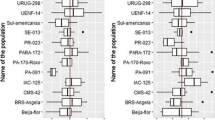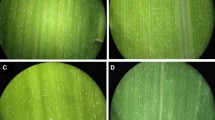Abstract
Bipolaris maydis (Y. Nisik. & C. Miyake) Shoemaker is a necrotrophic fungal pathogen that causes Southern corn leaf blight (SCLB) also known as a maydis leaf blight. This disease is found in almost all maize growing regions of world including India. In the present study, ten inbred lines of maize were screened for SCLB resistance in a randomized complete block design. After 36 days of sowing, the whorls of test plants were artificially inoculated with B. maydis spores. The intensity of the disease was recorded after 21 days of inoculation by scoring the randomly selected five plants from each plot using the disease scale of 1–5. The days required for anthesis, silking and anthesis-silking interval along with ear weight, grain yield, seed index, ear length, ear girth and kernels per ear were recorded. SCLB infection showed significant change in test parameters among maize inbred lines. Pearson correlation showed a negative correlation of anthesis silking interval and disease severity with yield-related attributes. During the infection, anthesis-silking interval was increased which was observed to be inversely proportional to grain yield. Principal component analysis classified the inbred lines into three groups with LM 13, LM 15 and CM 140 occupying distinct positions. Based on flowering and yield attributes, Wards cluster analysis showed that LM 13, LM 15 and CM 140 were distantly apart from each other. It may be concluded that LM 15 was highly susceptible to SCLB while LM 13 was a highly resistant inbred line. Yield reduction might be attributed to the differential flowering response of maize towards SCLB.







Similar content being viewed by others
References
Agrios GN (1997) Plant pathology. Academic Press, San Diego, CA
Aregbesola E, Ortega-Beltran A, Falade T, Jonathan G, Hearne S, Bandyopadhyay R (2020) A detached leaf assay to rapidly screen for resistance of maize to Bipolaris maydis, the causal agent of southern corn leaf blight. Eur J Plant Pathol 156:133–145. https://doi.org/10.1007/s10658-019-01870-4
Bhandari RR, Aryal L, Sharma S, Acharya M, Pokhrel A, Apar GC, Kaphle S, Sahadev KC, Shahi B, Bhattarai K, Chhetri A, Panthi S (2017) Screening of maize genotypes against southern leaf blight (Bipolaris maydis) during summer season in Nepal. World J Agric Res 5:31–41
Bolanos J, Edmeades GO (1993) Eight cycles of selection for drought tolerance in lowland tropical maize. II. Responses in reproductive behavior. Field Crops Res 31:253–268
Byrnes KJ, Pataky JK, White DG (1989) Relationships between yield of three maize hybrids and severity of southern leaf blight caused by race O of Bipolaris maydis. Plant Dis 73:834–840
Carson ML (2016) Foliar diseases. In: Munkvold GP, White DG (eds) Compendium of corn diseases. The American Phytopathological Society, St, Paul, pp 29–31
Das A, Parihar AK, Saxena D, Singh D, Singha KD, Kushwaha KPS, Chand R, Bal RS, Chandra S, Gupta S (2019) Deciphering genotype-by- environment interaction for targeting test environments and rust resistant genotypes in field pea (Pisum sativum L.). Front Plant Sci 10:825
Drechsler C (1925) Leaf spot of maize caused by Ophiobolus heterosrophus, the ascigenous stage of Helminthosporium exhibiting bipolar germination. J Agric Res 31:701–726
Echarte L, Nagore L, Di Matteo J, Cambareri M, Robles M, Della A (2013) Grain yield determination and resource use efficiency in maize hybrids released in different decades agricultural chemistry. Pleiades Publishing, Moscow, pp 19–36
Goudar SV, Harlapur SI (2019) Studies on loss assessment of maydis leaf blight (Bipolaris maydis. Nisikado) Shoemaker in maize. Int J Chem Stud 7:1831–1833
Hussain H, Raziq F, Khan I, Shah B, Altaf M, Attaullah UW, Naeem A, Adnan M, Junaid K, Shah SR, Iqbal M (2016) Effect of Bipolaris maydis (Y. Nisik & C. Miyake) shoemaker at various growth stages of different maize cultivars. J Entomol Zool Stud 4:439–444
Kumar J, Salgotra SK (2015) Evaluation of maize hybrids against leaf blight (Helminthosporium maydis and H. turcicum) and brown spot diseases (Physoderma zea maydis) of maize under mid hills of North-Western Himalayas. Maize Genom Genet 6:1–5
Lieberei R (2007) South American leaf blight of the rubber tree (Hevea spp.): new steps in plant domestication using physiological features and molecular markers. Ann Bot 100:1125–1142
Lilian J, Paul K, Daniel O, Mgonja M, Bernard T, Nicholas L, Henry O (2016) Yield losses and path coefficient analysis of head smut disease (Tolyposporium penicillariae) in pearl millet genotypes. Am J Exp Agric 13:1–10
Liu G, Kennedy R, Greenshields DL, Peng G, Forseille L, Selvaraj G, Wei Y (2007) Detached and attached Arabidopsis leaf assays reveal distinctive defense responses against hemibiotrophic Colletotrichum spp. Mol Plant Microbe Interact 20:1308–1319
Malik VK, Gogoi R, Hooda KS, Singh M (2017) Identification of multiple disease resistant maize accessions. Indian Phytopathol 70:80–85
Mikic SA, Kondic-spika L, Brbaklic D, Stanisavljevic D, Trkulja M, Tomicic A, Nastasic B, Kobiljski S, Prodanovic G, Surlan-Momirovic G (2016) Multiple marker-traits associations for maize agronomic traits. Chil J Agric Res 76:300–306
Mubeen S, Rafique M, Munis MFH, Chaudhary HJ (2017) Study of southern corn leaf blight (SCLB) on maize genotypes and its effect on yield. J Saudi Soc Agric Sci 16:210–217
Munjal RL, Kapoor JN (1960) Some unrecorded diseases of sorghum and maize from India. Curr Sci 29:442–443
Payak MM, Sharma RC (ed) (1983) Disease rating scales in maize in India. In: Techniques of scoring for resistance to important diseases of maize. All India Coordinated Maize Improvement Project, IARI, New Delhi
Reid A, Gonzalez V, Sikkema PH, Lee EA, Lukens L, Swanton CJ (2014) Delaying weed control lengthens the anthesis-silking interval in maize. Weed Sci 62:326–337
Severini AD, Borras L, Westgate ME, Cirilo AG (2011) Kernel number and kernel weight determination in dent and popcorn maize. Field Crops Res 120:360–369
Shah SS, Rahman H, Khalil IH, Rafi A (2006) Reaction of two maize synthetics to maydis leaf blight following recurrent selection for grain yield. Sarhad J Agric 22:263–269
Sharma RC, Rai SN (2005) Evaluation of maize inbred lines for resistance to maydis leaf blight. Indian Phytopathol 58:339–340
Shrestha J, Gurung DB, Dhital KP (2014) Agronomic performance of maize under high temperature condition. J Innov Biol 1:137–141
Singh M, Mehra R, Malik VK (2018) Evaluation of maize genotypes against Maydis leaf blight caused by Bipolaris maydis (Nisikado and Miyake) Shoemaker under artificial epiphytotic conditions. Int J Curr Microbiol Appl Sci 7:1006–1013
Srivastava RP, Singh R, Mani VP, Khandelwal RS, Alam M (2017) Additional sources of resistance for southern corn leaf blight in Indian maize germplasm. Ekin J Crop Breed Genet 3:41–44
Toit LJ, Pataky JK (1999) Effects of silk maturity and pollination on infection of maize ears by Ustilago maydis. Plant Dis 83:621–626
Tracy WF, Vargas C, Zepeda L, Pataky JK, Chandler MA (ed) (2007) Production and marketing of Huitlacoche. In: Issues in new crops and new uses. ASHS Press, Alexandria, pp 233–236
White DG (ed) (1999) Compendium of corn diseases. The American Phytopathological Society, St. Paul
Zwonitzer JC, Coles ND, Krakowsky MD, Arellano C, Holland JB, McMullen MD, Pratt RC, Balint-Kurti PJ (2010) Mapping resistance quantitative trait Loci for three foliar diseases in a maize recombinant inbred line population—evidence for multiple disease resistance? Phytopathology 100:72–77
Acknowledgements
One of the authors is grateful to the Indian Council of Agricultural Research, New Delhi, India for providing financial assistance for this work, vide File No. EDN/1/27/2015/SRF.
Author information
Authors and Affiliations
Corresponding author
Ethics declarations
Conflict of interest
The authors declare that they have no conflict of interest.
Additional information
Publisher's Note
Springer Nature remains neutral with regard to jurisdictional claims in published maps and institutional affiliations.
Rights and permissions
About this article
Cite this article
Vasmatkar, P., Kaur, K. & Pannu, P.P.S. Field based assessment of yield-related traits and flowering response in Zea mays towards Southern corn leaf blight. Indian Phytopathology 74, 969–979 (2021). https://doi.org/10.1007/s42360-021-00404-5
Received:
Revised:
Accepted:
Published:
Issue Date:
DOI: https://doi.org/10.1007/s42360-021-00404-5




